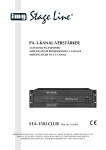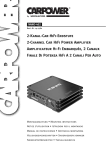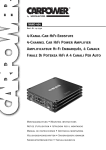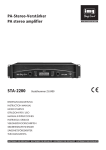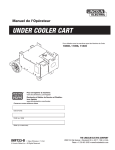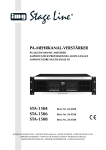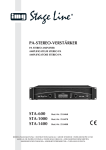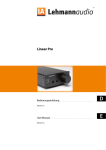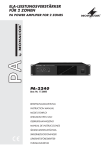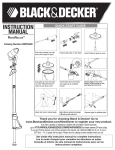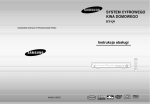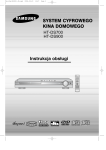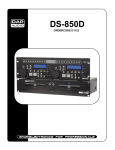Download DIGITAL-PA-VERSTÄRKER MIT 4 ODER 8 KANÄLEN
Transcript
DIGITAL-PA-VERSTÄRKER MIT 4 ODER 8 KANÄLEN DIGITAL PA AMPLIFIER WITH 4 OR 8 CHANNELS AMPLIFICATEUR PA DIGITAL AVEC 4 OU 8 CANAUX AMPLIFICATORE PA DIGITALE CON 4 O 8 CANALI STA-450D STA-850D Bestellnummer 25.2350 Bestellnummer 25.2360 BEDIENUNGSANLEITUNG • INSTRUCTION MANUAL • MODE D’EMPLOI ISTRUZIONI PER L’USO • MANUAL DE INSTRUCCIONES • INSTRUKCJA OBSŁUGI VEILIGHEIDSVOORSCHRIFTEN • SIKKERHEDSOPLYSNINGER • SÄKERHETSFÖRESKRIFTER • TURVALLISUUDESTA D Bevor Sie einschalten … A Wir wünschen Ihnen viel Spaß mit Ihrem neuen Gerät von „img Stage Line“. Bitte lesen Sie diese Bedienungsanleitung vor dem Betrieb gründlich durch. Nur so lernen Sie alle Funktionsmöglichkeiten kennen, vermeiden Fehlbedienungen und schützen sich und Ihr Gerät vor eventuellen Schäden durch unsachgemäßen Gebrauch. Heben Sie die Anleitung für ein späteres Nachlesen auf. We wish you much pleasure with your new “img Stage Line” unit. Please read these operating instructions carefully prior to operating the unit. Thus, you will get to know all functions of the unit, operating errors will be prevented, and yourself and the unit will be protected against any damage caused by improper use. Please keep the operating instructions for later use. Der deutsche Text beginnt auf der Seite 4. The English text starts on page 6. CH GB Before switching on … F Avant toute installation … B Nous vous souhaitons beaucoup de plaisir à utiliser cet appareil “img Stage Line”. Lisez ce mode dʼemploi entièrement avant toute utilisation. Uniquement ainsi, vous pourrez apprendre lʼensemble des possibilités de fonctionnement de lʼappareil, éviter toute manipulation erronée et vous protéger, ainsi que lʼappareil, de dommages éventuels engendrés par une utilisation inadaptée. Conservez la notice pour pouvoir vous y reporter ultérieurement. Vi auguriamo buon divertimento con il vostro nuovo apparecchio di “img Stage Line”. Leggete attentamente le istruzioni prima di mettere in funzione lʼapparecchio. Solo così potete conoscere tutte le funzionalità, evitare comandi sbagliati e proteggere voi stessi e lʼapparecchio da eventuali danni in seguito ad un uso improprio. Conservate le istruzioni per poterle consultare anche in futuro. La version française se trouve page 8. Il testo italiano inizia a pagina 10. CH E Antes de la utilización … I PL Le deseamos una buena utilización para su nuevo aparato “img Stage Line”. Por favor, lea estas instrucciones de uso atentamente antes de hacer funcionar el aparato. De esta manera conocerá todas las funciones de la unidad, se prevendrán errores de operación, usted y el aparato estarán protegidos en contra de todo daño causado por un uso inadecuado. Por favor, guarde las instrucciones para una futura utilización. Prima di accendere … Przed uruchomieniem … Życzymy zadowolenia z nowego produktu “img Stage Line”. Dzięki tej instrukcji obsługi będą państwo w stanie poznać wszystkie funkcje tego urządzenia. Stosując się do instrukcji unikną państwo błędów i ewentualnego uszkodzenia urządzenia na skutek nieprawidłowego użytkowania. Prosimy zachować instrukcję. Tekst polski zaczyna się na stronie 14. La versión española comienza en la página 12. NL B Voor u inschakelt … DK Før du tænder … Tillykke med dit nye “img Stage Line” produkt. Læs sikkerhedsanvisningerne nøje før ibrugtagning, for at beskytte Dem og enheden mod skader, der skyldes forkert brug. Gem venligst denne betjeningsvejledning til senere brug. Wij wensen u veel plezier met uw nieuwe apparaat van “img Stage Line”. Lees de veiligheidsvoorschriften grondig door, alvorens het apparaat in gebruik te nemen. Zo behoedt u zichzelf en het apparaat voor eventuele schade door ondeskundig gebruik. Bewaar de handleiding voor latere raadpleging. Sikkerhedsanvisningerne findes på side 16. De veiligheidsvoorschriften vindt u op pagina 16. S Innan du slår på enheten … FIN Ennen kytkemistä … Vi önskar dig mycket glädje med din nya “img Stage Line” produkt. Läs igenom säkerhetsföreskrifterna innan enheten tas i bruk för att undvika skador till följd av felaktig hantering. Behåll instruktionerna för framtida bruk. Toivomme Sinulle paljon miellyttäviä hetkiä uuden “img Stage Line” laitteen kanssa. Ennen laitteen käyttöä pyydämme Sinua huolellisesti tutustumaan turvallisuusohjeisiin. Näin vältyt vahingoilta, joita virheellinen laitteen käyttö saattaa aiheuttaa. Ole hyvä ja säilytä käyttöohjeet myöhempää tarvetta varten. Säkerhetsföreskrifterna återfinns på sidan 17. Turvallisuusohjeet löytyvät sivulta 17. www.imgstageline.com 2 STA-450D 1 2 4 3 STA-850D 1 2 4 3 STA-450D 5 6 7 8 9 STA-850D Anschlussmöglichkeit je Ausgang Connecting possibility per output Betriebsart Mode Z je Lautsprecher Z per speaker PMIN je Lautsprecher PMIN per speaker 4Ω 50 W 8Ω 30 W 8Ω 100 W 8Ω 25 W 16 Ω 15 W 16 Ω 50 W 4Ω 15 W – – 4Ω 50 W 4Ω 12,5 W 8Ω 7,5 W 8Ω 25 W NORMAL + - BRIDGE + + - - NORMAL BRIDGE + NORMAL - + - 3 BRIDGE + + - - + + - - NORMAL BRIDGE 10 D A Auf der ausklappbaren Seite 3 finden Sie alle beschriebenen Bedienelemente und Anschlüsse. G CH 1 Übersicht der Bedienelemente und Anschlüsse 1 Taste MUTE zum Stummschalten des zugehörigen Kanals 2 Anzeige CLIP für jeden Kanal leuchtet bei Übersteuerung des Kanals 3 Lautstärkeregler LEVEL für jeden Kanal G Ziehen Sie den Netzstecker nie am Kabel aus der Steckdose, fassen Sie immer am Stecker an. G Verwenden Sie für die Reinigung nur ein trockenes, weiches Tuch, niemals Wasser oder Chemikalien. G Wird das Gerät zweckentfremdet, nicht richtig angeschlossen, falsch bedient oder nicht fachgerecht repariert, kann keine Haftung für daraus resultierende Sach- oder Personenschäden und keine Garantie für das Gerät übernommen werden. 4 Ein- und Ausschalter POWER 5 symmetrische Eingänge als XLR-Buchsen für jeden Kanal; bei Brückenbetrieb jeweils nur den Eingang mit ungerader Nummer anschließen 6 asymmetrische Eingänge als Cinch-Buchsen für jeden Kanal; bei Brückenbetrieb jeweils nur den Eingang mit ungerader Nummer anschließen 7 Schalter für den Betriebsmodus, jeweils für ein Kanalpaar NORMAL = jeder Kanal arbeitet separat BRIGDE = Brückenbetrieb Soll das Gerät endgültig aus dem Betrieb genommen werden, übergeben Sie es zur umweltgerechten Entsorgung einem örtlichen Recyclingbetrieb. 8 Lautsprecheranschlüsse 3 Einsatzmöglichkeiten 9 Halterung für die Netzsicherung Eine geschmolzene Sicherung nur durch eine gleichen Typs ersetzen! Dieser Digital-Verstärker ist optimal für die gleichzeitige Beschallung mehrerer Räume geeignet. Das Modell STA-450D ist dazu mit vier Kanälen ausgestattet, das Modell STA-850D mit acht. Jeder Kanal kann eine Sinusleistung von 50 W abgeben. Für eine höhere Ausgangsleistung lassen sich jeweils zwei Kanäle in Brücke schalten. Durch die Brückenschaltung kann dann je Kanalpaar eine Sinusleistung von 100 W abgegeben werden. 10 Netzbuchse zum Anschluss an eine Steckdose (230 V~ / 50 Hz) über das beiliegende Netzkabel 2 Hinweise für den sicheren Gebrauch Das Gerät entspricht allen erforderlichen Richtlinien der EU und ist deshalb mit gekennzeichnet. WARNUNG Das Gerät wird mit lebensgefährlicher Netzspannung versorgt. Nehmen Sie deshalb niemals selbst Eingriffe am Gerät vor und stecken Sie nichts durch die Lüftungsöffnungen! Es besteht die Gefahr eines elektrischen Schlages. Beachten Sie auch unbedingt die folgenden Punkte: 4 Nehmen Sie das Gerät nicht in Betrieb und ziehen Sie sofort den Netzstecker aus der Steckdose, 1. wenn sichtbare Schäden am Gerät oder am Netzkabel vorhanden sind, 2. wenn nach einem Sturz oder Ähnlichem der Verdacht auf einen Defekt besteht, 3. wenn Funktionsstörungen auftreten. Geben Sie das Gerät in jedem Fall zur Reparatur in eine Fachwerkstatt. G Das Gerät ist nur zur Verwendung im Innenbereich geeignet. Schützen Sie es vor Tropfund Spritzwasser, hoher Luftfeuchtigkeit und Hitze (zulässiger Einsatztemperaturbereich 0 – 40 °C). G Stellen Sie keine mit Flüssigkeit gefüllten Gefäße, z. B. Trinkgläser, auf das Gerät. G Die in dem Gerät entstehende Wärme muss durch Luftzirkulation abgegeben werden. Decken Sie darum die Lüftungsöffnungen des Gehäuses nicht ab. 4 Aufstellmöglichkeiten Der Verstärker ist für den Einschub in ein Rack (482 mm / 19″) vorgesehen, kann aber auch als Tischgerät verwendet werden. In jedem Fall muss Luft ungehindert durch alle Lüftungsöffnungen strömen können, damit eine ausreichende Kühlung gewährleistet ist. 4.1 Rackeinbau Für die Montage in ein Rack werden 2 HE benötigt (HE = Höheneinheit = 44,45 mm). Damit das Rack nicht kopflastig wird, muss der Verstärker im unteren Bereich des Racks eingeschoben werden. Für eine sichere Befestigung reicht die Frontplatte allein nicht aus. Zusätzlich müssen Seitenschienen oder eine Bodenplatte das Gerät halten. Die vom Verstärker abgegebene, erhitzte Luft muss aus dem Rack austreten können. Anderenfalls kommt es im Rack zu einem Hitzestau, wodurch nicht nur der Verstärker, sondern auch andere Geräte im Rack beschädigt werden können. Bei unzureichendem Wärmeabfluss in das Rack eine Lüftereinheit einsetzen. 5 Verstärker anschließen Alle Anschlüsse dürfen nur bei ausgeschaltetem Gerät hergestellt oder verändert werden! 1) Die Signalquellen (z. B. CD-Spieler, Vorverstärker, Mischpult) an die Buchsen INPUT (5, 6) anschließen. Die XLR-Buchsen (5) sind für symmetrische Signale beschaltet und benötigen für eine Vollaussteuerung ein Eingangssignal von mindestens 550 mV. Signalquellen mit asymmetrischen Signalen an die Cinch-Buchsen (6) anschließen. Für eine Vollaussteuerung wird ein Signal von mindestens 1 V benötigt. Bei den Kanalpaaren, die im Brückenbetrieb arbeiten sollen ( Kap. 6.1), jeweils nur den Eingang mit ungerader Nummer anschließen. 2) Die Lautsprecher an die Klemmen OUTPUT (8) anschließen. Die erforderliche Nennbelastbarkeit (PMIN) der Lautsprecher ist in der Tabelle auf der Seite 3 angegeben. Bei den Kanälen, die im Normalbetrieb arbeiten [Schalter (7) in Position NORMAL], jeweils die gekennzeichnete Ader der Lautsprecherleitung mit der roten Klemme verbinden und die andere Ader mit der schwarzen Klemme. Beim Normalbetrieb wird die größte Ausgangsleistung mit 4-Ω-Lautsprechern erreicht. Lautsprecher mit einer geringeren Impedanz (Z) dürfen nicht angeschlossen werden, sonst kann der Verstärker beschädigt werden. Es können jedoch 8-Ω-Lautsprecher angeschlossen werden, was die Ausgangsleistung aber etwas verringert. Bei den Kanalpaaren, die im Brückenbetrieb arbeiten [Schalter (7) in Position BRIGDE], jeweils die gekennzeichnete Ader der Lautsprecherleitung mit der linken, roten Klemme des Kanalpaares verbinden und die andere Ader mit der rechten, roten Klemme (siehe Aufdruck BRIDGE an den Klemmen). Im Brückenbetrieb wird die größte Ausgangsleistung mit einem 8-Ω-Lautsprecher erreicht. Lautsprecher mit einer geringeren Impedanz (Z) dürfen nicht angeschlossen werden, sonst kann der Verstärker beschädigt werden. Es können jedoch Lautsprecher mit einer größeren Impedanz angeschlossen werden, was die Ausgangsleistung aber etwas verringert. 3) Das Netzkabel erst in die Netzbuchse (10) und dann den Netzstecker des Kabels in eine Steckdose (230 V~/ 50 Hz) stecken. 6 Bedienung 7 Technische Daten D A 6.1 Betriebsart wählen Modell STA-450D STA-850D Mit den Schaltern OPERATING MODE (7) für jedes Kanalpaar einzeln die gewünschte Betriebsart wählen: Sinus-Ausgangsleistung Normalbetrieb an 4 Ω Normalbetrieb an 8 Ω Brückenbetrieb an 8 Ω 4 × 50 W 4 × 30 W 2 × 100 W 8 × 50 W 8 × 30 W 4 × 100 W maximale Gesamtleistung 300 W 600 W NORMAL = Normalbetrieb, bei dem jeder Kanal eines Kanalpaares separat arbeitet, d. h. jeder Kanal erhält ein eigenes Eingangssignal, das mit 50 W Sinusleistung (an 4 Ω) am zugehörigen Ausgang zur Verfügung steht. BRIDGE = Brückenbetrieb, bei dem die Kanäle eines Kanalpaares zur Leistungsverdopplung in Brücke zusammengeschaltet sind. An den zugehörigen Ausgangsklemmen stehen 100 W (an 8 Ω) zur Verfügung. Das Eingangssignal jeweils nur auf die Buchse mit der zugehörigen ungeraden Nummer geben. 6.2 Verstärker ein- / ausschalten Zur Vermeidung von lauten Schaltgeräuschen den Endverstärker in einer Verstärkeranlage immer nach allen anderen Geräten einschalten und ihn nach dem Betrieb als erstes Gerät wieder ausschalten. Vor dem ersten Einschalten die Regler LEVEL (3) ganz nach links auf Null drehen. Den Verstärker mit dem Schalter POWER (4) einschalten. Der Schalter leuchtet als Betriebsanzeige. Eingangsempfindlichkeit für Nennleistung XLR-Buchsen Cinch-Buchsen 550 mV 1V Eingangsimpedanz 20 kΩ Frequenzbereich 10 – 20 000 Hz Übersprechdämpfung > 45 dB Ausgangsschaltung Class D Einsatztemperatur 0 – 40 °C Stromversorgung max. Leistungsaufnahme Abmessungen (B × H × T) Gewicht CH 230 V~/ 50 Hz 300 VA 230 V~/ 50 Hz 600 VA 482 × 89 × 330 mm 2 HE (Höheneinheiten) 7,2 kg 10,5 kg Änderungen vorbehalten. 6.3 Lautstärke einstellen Kanal stummschalten 1) Die Ausgänge der Signalquellen (z. B. Mischpult, Vorverstärker) auf den Nennpegel (0 dB) oder auf das größte unverzerrte Ausgangssignal aussteuern. 2) Die Regler LEVEL (3) der benutzten Kanäle so weit aufdrehen, bis die maximal gewünschte Lautstärke erreicht ist. Die Regler der nicht verwendeten Kanäle auf Null drehen. Bei den Kanalpaaren, die im Brückenbetrieb arbeiten, die Lautstärke nur mit dem zugehörigen linken Regler (CHANNEL 1, 3, 5 oder 7) einstellen. Den anderen Regler auf Null stellen; er ist ohne Funktion. VORSICHT Stellen Sie die Lautstärke am Verstärker nie sehr hoch ein. Hohe Lautstärken können auf Dauer das Gehör schädigen! Das Ohr gewöhnt sich an große Lautstärken und empfindet sie nach einiger Zeit als nicht mehr so hoch. Darum eine hohe Lautstärke nach der Gewöhnung nicht weiter erhöhen. Leuchtet eine der roten Anzeigen CLIP (2) kurz auf, ist die maximal mögliche Lautstärke erreicht. Leuchtet sie öfter kurz auf, wird der Kanal übersteuert. In diesem Fall den zugehörigen Regler etwas zurückdrehen. 3) Jeder Kanal lässt sich separat stummschalten, z. B. wenn für eine Ansprache die Hintergrundmusik stört. Dazu die zugehörige Taste MUTE (1) drücken. Bei den Kanalpaaren, die im Brückenbetrieb arbeiten, braucht jeweils nur die entsprechende linke Taste MUTE (CHANNEL 1, 3, 5 oder 7) gedrückt zu werden. Die andere Taste ist ohne Funktion. Diese Bedienungsanleitung ist urheberrechtlich für MONACOR ® INTERNATIONAL GmbH & Co. KG geschützt. Eine Reproduktion für eigene kommerzielle Zwecke – auch auszugsweise – ist untersagt. 5 GB All operating elements and connections can be found on the fold-out page 3. 1 Operating Elements and Connections 1 Button MUTE to mute the corresponding channel 2 Indication CLIP for each channel lights up when the channel is overloaded 3 Volume control LEVEL for each channel 4 On / off switch POWER 5 Balanced inputs as XLR jacks for each channel; in case of bridge operation, only connect the odd-numbered input in each case 6 Unbalanced inputs as phono jacks for each channel; in case of bridge operation, only connect the odd-numbered input in each case 7 Switch for the operating mode, each for one channel pair NORMAL = each channel operates separately BRIDGE = bridge operation 8 Speaker terminals 9 Support for the mains fuse Only replace a blown fuse by one of the same type! 10 Mains jack for connection to a socket (230 V~ / 50 Hz) via the supplied mains cable 2 Safety Notes The unit corresponds to all required directives of the EU and is therefore marked with . WARNING The unit is supplied with hazardous mains voltage. Leave servicing to skilled personnel only and do not insert anything through the air vents! This may cause an electric shock hazard. It is essential to observe the following items: 6 G The unit is suitable for indoor use only. Protect it against dripping water and splash water, high air humidity, and heat (admissible ambient temperature range 0 – 40 °C). G Do not place any vessels filled with liquid, e. g. drinking glasses, on the unit. G The heat being generated in the unit must be carried off by air circulation. Therefore, the air vents at the housing must not be covered. G Do not set the unit into operation, and immediately disconnect the mains plug from the mains socket if 1. there is visible damage to the unit or to the mains cable, 2. a defect might have occurred after a drop or similar accident, 3. malfunctions occur. The unit must in any case be repaired by skilled personnel. G Never pull the mains cable to disconnect the mains plug from the mains socket, always seize the plug. G For cleaning only use a dry, soft cloth, never use chemicals or water. G G No guarantee claims for the unit and no liability for any resulting personal damage or material damage will be accepted if the unit is used for other purposes than originally intended, if it is not correctly connected or operated, or not repaired in an expert way. Important for U. K. Customers! The wires in this mains lead are coloured in accordance with the following code: green/yellow = earth blue = neutral brown = live As the colours of the wires in the mains lead of this appliance may not correspond with the coloured markings identifying the terminals in your plug, proceed as follows: 1. The wire which is coloured green and yellow must be connected to the terminal in the plug which is marked with the letter E or by the earth symbol , or coloured green or green and yellow. 2. The wire which is coloured blue must be connected to the terminal which is marked with the letter N or coloured black. 3. The wire which is coloured brown must be connected to the terminal which is marked with the letter L or coloured red. Warning – This appliance must be earthed. If the unit is to be put out of operation definitively, take it to a local recycling plant for a disposal which is not harmful to the environment. 3 Applications This digital amplifier is suited in an optimum way for simultaneous PA application in several rooms. For this purpose model STA-450D is equipped with four channels, model STA-850D with eight channels. Each channel is able to deliver an rms power of 50 W. For a higher output power two channels each can be bridged. Due to the bridge circuit an rms power of 100 W can be delivered per channel pair. 4 Setting-Up The amplifier is provided for installation into a rack (482 mm / 19″), but it may also be used as a tabletop unit. In each case, air must be allowed to flow freely through all ventilation slots so that a sufficient cooling is ensured. 4.1 Rack installation For rack mounting, 2 rs (rs = rack space = 44.45 mm) are required. To prevent top-heaviness of the rack, the amplifier must be inserted in the lower part of the rack. To ensure a safe fixing, the front panel alone is not sufficient. In addition, the unit must be supported by means of lateral rails or a bottom plate. The heated air blown out by the amplifier must be able to dissipate from the rack, otherwise a heat accumulation will occur in the rack which may not only damage the amplifier but also other units in the rack. In case the heat is not dissipated sufficiently, a fan unit has to be inserted into the rack. 5 Connecting the Amplifier All connections must only be made or changed with the unit switched off! 1) Connect the signal sources (e. g. CD player, preamplifier, mixer) to the jacks INPUT (5, 6). The XLR jacks (5) are designed for balanced signals and require for rated power an input signal of 550 mV as a minimum. Connect signal sources with unbalanced signals to the phono jacks (6). For rated power a signal of 1 V as a minimum is required. For channel pairs intended for bridge operation ( chapter 6.1), only connect the oddnumbered input in each case. 2) Connect the speakers to the terminals OUTPUT (8). The table on page 3 shows the required power rating (PMIN) of the speakers. For channels operating in normal operation [switch (7) in position NORMAL], connect in each case the marked core of the speaker cable to the red terminal and the other core to the black terminal. For normal operation the highest output power will be reached with 4 Ω speakers. Speakers with lower impedance (Z) must not be connected, otherwise the amplifier may be damaged. 8 Ω speakers may be connected, however, in this case the output power will slightly decrease. For channel pairs operating in bridge operation [switch (7) in position BRIDGE], connect in each case the marked core of the speaker cable to the left, red terminal of the channel pair and the other core to the right, red terminal (see imprint BRIDGE at the terminals). In bridge operation the maximum output power will be reached with an 8 Ω speaker. Speakers with lower impedance (Z) must not be connected, otherwise the amplifier may be damaged. Speakers with higher impedance may be connected, however, in this case the output power will slightly decrease. 3) First connect the mains cable to the mains jack (10) and then the mains plug of the cable to a socket (230 V~ / 50 Hz). 6 Operation 6.1 Selecting the operating mode Select the desired operating mode for each channel pair with the switches OPERATING MODE (7): NORMAL = normal operation, each channel of a channel pair operates separately, i. e. each channel receives an input signal of its own which is available with 50 WRMS power (at 4 Ω) at the corresponding output. BRIDGE = bridge operation, the channels of a channel pair are bridged for power doubling. 100 W (at 8 Ω) are available at the corresponding output terminals. Only feed the input signal to the corresponding odd-numbered jack in each case. 6.2 Switching the amplifier on/off To prevent loud switching noise, always switch on the power amplifier in an amplifier system after all other units have been switched on and switch it off first after operation. Prior to first switching-on, set the controls LEVEL (3) to the left stop to zero. Switch on the amplifier with the POWER switch (4). The switch lights up as a power indication. 6.3 Adjusting the volume muting the channel 7 Specifications GB Model STA-450D STA-850D RMS output power normal operation at 4 Ω normal operation at 8 Ω bridge operation at 8 Ω 4 × 50 W 4 × 30 W 2 × 100 W 8 × 50 W 8 × 30 W 4 × 100 W 300 W 600 W Maximum total power Input sensitivity for rated power XLR jacks phono jacks 550 mV 1V Input impedance 20 kΩ Frequency range 10 – 20 000 Hz Crosstalk > 45 dB Output circuit class D Ambient temperature 0 – 40 °C Power supply Max. power consumption Dimensions (W × H × D) Weight 230 V~/ 50 Hz 300 VA 230 V~/ 50 Hz 600 VA 482 × 89 × 330 mm 2 RS (rack spaces) 7.2 kg 10.5 kg Subject to technical modification. 1) Adjust the outputs of the signal sources (e. g. mixer, preamplifier) to the rated level (0 dB) or the maximum undistorted output signal. 2) Turn up the controls LEVEL (3) of the channels used so far until the maximum desired volume is reached. Turn the controls of the channels not used to zero. For channel pairs operating in bridge mode, only adjust the volume with the corresponding left control (CHANNEL 1, 3, 5 or 7). Set the other control to zero; it does not have any function. CAUTION Never adjust the amplifier to a very high volume. Permanent high volumes may damage your hearing! The human ear will get accustomed to high volumes which do not seem to be that high after some time. Therefore, do not further increase a high volume after getting used to it. If one of the red indications CLIP (2) shortly lights up, the maximum possible volume will be reached. If it shortly lights up more frequently, the channel is overloaded. In this case slightly turn back the corresponding control. 3) Each channel may be muted separately, e. g. if the background music is disturbing for an announcement. For this purpose press the corresponding button MUTE (1). For channel pairs operating in bridge mode, it is only necessary to press the corresponding left button MUTE (CHANNEL 1, 3, 5 or 7). The other button does not have any function. All rights reserved by MONACOR ® INTERNATIONAL GmbH & Co. KG. No part of this instruction manual may be reproduced in any form or by any means for any commercial use. 7 F B Ouvrez le présent livret page 3, dépliable, de manière à visualiser les éléments et branchements. CH G 1 Eléments et branchements 1 Touche MUTE pour couper le canal correspondant 2 LED CLIP pour chaque canal brille en cas de surcharge du canal 3 Potentiomètre de réglage du volume pour chaque canal 4 Interrupteur marche / arrêt POWER 5 Entrées symétriques, prises XLR, pour chaque canal ; en mode bridgé, reliez uniquement lʼentrée avec le numéro impair 6 Entrées asymétriques, prises RCA, pour chaque canal ; en mode bridgé, reliez uniquement lʼentrée avec le numéro impair 7 Interrupteur pour le mode de fonctionnement, respectivement pour une paire de canaux : NORMAL = chaque canal fonctionne séparément BRIDGE = mode bridgé 8 Branchements haut-parleur 9 Porte fusible Tout fusible fondu doit être remplacé par un fusible de même type. 10 Prise secteur à relier à une prise 230 V~ / 50 Hz via le cordon secteur livré 2 Conseils de sécurité et dʼutilisation Lʼappareil répond à toutes les directives nécessaires de lʼUnion européenne et porte donc le symbole . AVERTISSEMENT Lʼappareil est alimenté par une tension dangereuse. Ne touchez jamais lʼintérieur de lʼappareil et ne faites rien tomber dans les ouïes de ventilation car, en cas de mauvaise manipulation, vous pouvez subir une décharge électrique. Respectez scrupuleusement les points suivants : 8 G G Lʼappareil nʼest conçu que pour une utilisation en intérieur. Protégez-le des éclaboussures, de tout type de projections dʼeau, dʼune humidité dʼair élevée et de la chaleur (température ambiante admissible 0 – 40 °C). G En aucun cas, vous ne devez pas poser dʼobjet contenant du liquide ou un verre sur lʼappareil. G La chaleur dégagée par lʼappareil doit être évacuée par une circulation dʼair correcte. Nʼobstruez pas les ouïes de ventilation du boîtier. G Ne faites pas fonctionner lʼappareil et débranchez le cordon secteur immédiatement dans les cas suivants : 1. lʼappareil ou le cordon secteur présentent des dommages visibles. 2. après une chute ou accident similaire, vous avez un doute sur lʼétat de lʼappareil. 3. des dysfonctionnements apparaissent. Dans tous les cas, les dommages doivent être réparés par un technicien spécialisé. G Ne débranchez jamais lʼappareil en tirant sur le cordon secteur ; retirez toujours le cordon secteur en tirant la fiche. Pour le nettoyage, utilisez un chiffon sec et doux, en aucun cas de produits chimiques ou dʼeau. Nous déclinons toute responsabilité en cas de dommages corporels ou matériels résultants si lʼappareil est utilisé dans un but autre que celui pour lequel il a été conçu, sʼil nʼest pas correctement branché, utilisé ou réparé par une personne habilitée ; en outre, la garantie deviendrait caduque. Lorsque lʼappareil est définitivement retiré du service, vous devez le déposer dans une usine de recyclage de proximité pour contribuer à son élimination non polluante. 3 Possibilités dʼutilisation Cet amplificateur digital est idéal pour une sonorisation simultanée de plusieurs pièces. Le modèle STA-450D est doté de 4 canaux, le modèle STA-850D de 8 canaux. Chaque canal peut délivrer une puissance rms de 50 W. Pour une puissance de sortie supérieure, on peut commuter deux canaux en mode bridgé. Ainsi, on peut avoir en mode bridgé une puissance rms de 100 W par paire de canaux. 4 Possibilités de positionnement Lʼamplificateur est conçu pour une installation en rack (482 mm / 19″) mais peut être également posé directement sur une table. Dans tous les cas, lʼair doit pouvoir passer sans encombre via les ouïes dʼaération pour assurer un refroidissement suffisant. 4.1 Installation en rack Pour un montage en rack, 2 unités (1 unité = 44,45 mm) sont nécessaires. Afin que le rack ne se renverse pas, vous devez placer lʼamplificateur dans la partie inférieure du rack. Pour une fixation solide, la plaque avant seule nʼest pas suffisante, lʼamplificateur doit en plus, être maintenu par des rails latéraux ou une plaque inférieure. Lʼair chaud dégagé par lʼappareil doit pouvoir être évacué du rack. Sinon, il y a accumulation de chaleur dans le rack, ce qui peut endommager non seulement lʼamplificateur mais dʼautres appareils placés dans le rack. En cas de dégagement insuffisant de la chaleur, installez un ventilateur dans le rack. 5 Branchements de lʼamplificateur Les branchements ne doivent être effectués que lorsque lʼamplificateur est éteint ! 1) Reliez les sources de signal (p. ex. lecteur CD, préamplificateur, table de mixage) aux prises INPUT (5, 6). Les prises XLR (5) sont prévues pour des signaux symétriques et nécessitent pour une puissance nominale un signal dʼentrée de 550 mV au moins. Reliez les sources de signal avec signaux asymétriques aux prises RCA (6). Pour une puissance nominale un signal de 1 V au moins est nécessaire. Pour des paires de canaux devant fonctionner en mode bridgé ( chapitre 6.1), reliez respectivement uniquement lʼentrée avec le numéro impair. 2) Reliez les haut-parleurs aux bornes OUTPUT (8). La capacité de charge nominale nécessaire (PMIN) des haut-parleurs est indiquée dans le tableau, page 3. Pour les canaux fonctionnant en mode normal [interrupteur (7) sur la position NORMAL], reliez respectivement le conducteur repéré du câble haut-parleur à la borne rouge et lʼautre conducteur à la borne noire. Pour un fonctionnement normal, la puissance de sortie la plus grande est atteinte avec des haut-parleurs 4 Ω. Il ne faut pas relier de haut-parleurs avec une impédance (Z) inférieure, lʼamplificateur peut être endommagé. On peut également relier des haut-parleurs 8 Ω mais la puissance de sortie en est diminuée. Pour des paires de canaux fonctionnant en mode bridgé [interrupteur (7) sur la position BRIDGE], reliez respectivement le conducteur repéré du câble haut-parleur à la borne gauche rouge de la paire de canaux et lʼautre conducteur à la borne droite rouge (voir inscription BRIDGE sur les bornes). En mode bridgé, la puissance de sortie la plus grande est atteinte avec des haut-parleurs 8 Ω. Il ne faut pas relier de haut-parleurs avec une impédance (Z) inférieure, lʼamplificateur peut être endommagé. On peut également relier des haut-parleurs supérieure mais la puissance de sortie en est diminuée. 3) Reliez le cordon secteur à la prise (10) puis lʼautre extrémité à une prise secteur 230 V~/ 50 Hz. 6 Utilisation 7 Caractéristiques techniques F B 6.1 Sélection du mode de fonctionnement Sélectionnez le mode de fonctionnement souhaité avec les interrupteurs OPERATING MODE (7) pour chaque paire de canal séparément : NORMAL = fonctionnement normal, chaque canal dʼune paire de canaux fonctionne séparément, cʼest-à-dire que chaque canal reçoit un signal dʼentrée propre qui est à disposition à la sortie correspondante avec une puissance rms de 50 W (sous 4 Ω). Modèle STA-450D STA-850D Puissance de sortie rms mode normal sous 4 Ω mode normal sous 8 Ω mode bridgé sous 8 Ω 4 × 50 W 4 × 30 W 2 × 100 W 8 × 50 W 8 × 30 W 4 × 100 W 300 W 600 W Puissance maximale totale Sensibilité dʼentrée pour puissance nominale prises XLR prises RCA BRIDGE = fonctionnement bridgé, les canaux dʼune paire de canaux sont branchés ensemble pour doubler la puissance. 100 W (sous 8 Ω) sont disponibles aux bornes de sortie correspondantes. Appliquez le signal dʼentrée respectivement et uniquement à la prise avec le numéro impair correspondant. Impédance dʼentrée 6.2 Marche/arrêt de lʼamplificateur Alimentation Consommation max. Pour éviter les bruits forts de commutation, allumez toujours lʼétage final dʼune installation dʼamplificateur, après tous les autres appareils et éteignez-le en premier après lʼutilisation. Avant la première mise en service, tournez les réglages LEVEL (3) vers la gauche sur 0. Allumez lʼamplificateur avec lʼinterrupteur POWER (4). Lʼinterrupteur brille servant de témoin de fonctionnement. 550 mV 1V 20 kΩ Bande passante 10 – 20 000 Hz Séparation des canaux > 45 dB Circuit sortie Classe D Température fonc. 0 – 40 °C Dimensions (L × H × P) Poids CH 230 V~/ 50 Hz 300 VA 230 V~/ 50 Hz 600 VA 482 × 89 × 330 mm 2 U (unités) 7,2 kg 10,5 kg Tout droit de modification réservé. 6.3 Réglage de volume/coupure de canal 1) Réglez les sorties des sources de signal (par exemple table de mixage, préamplificateur) sur le niveau nominal (0 dB) ou sur le signal de sortie non distordu le plus grand. 2) Tournez les réglages LEVEL (3) des canaux utilisés jusquʼà obtenir le volume maximal souhaité. Mettez les réglages des canaux inutilisés sur zéro. Pour des paires de canaux fonctionnant en mode bridgé, réglez le volume uniquement avec le réglage gauche correspondant (CHANNEL 1, 3, 5 ou 7). Mettez lʼautre réglage sur zéro, il est sans fonction. AVERTISSEMENT Ne réglez jamais le volume, sur lʼamplificateur, de manière très élevée. Un volume trop élevé peut, à long terme, générer des troubles de lʼaudition. Lʼoreille humaine sʼhabitue à des volumes élevés et ne les perçoit plus comme tels au bout dʼun certain temps. Nous vous conseillons donc de régler le volume et de ne plus le modifier. Si une des LEDs rouges CLIP (2) brille brièvement, le volume maximal possible est atteint. Si elle brille brièvement plus souvent, le canal est en surcharge, tournez dans ce cas le réglage un peut dans lʼautre sens. 3) Chaque canal peut être coupé séparément, par exemple lorsque la musique de fond gêne pour une annonce. Appuyez alors sur la touche MUTE (1) correspondante. Pour des paires de canaux fonctionnant en mode bridgé, il suffit dʼenfoncer la touche gauche correspondante MUTE (CHANNEL 1, 3, 5 ou 7). Lʼautre touche est sans fonction. Notice dʼutilisation protégée par le copyright de MONACOR ® INTERNATIONAL GmbH & Co. KG. Toute reproduction même partielle à des fins commerciales est interdite. 9 I A pagina 3, se aperta completamente, vedrete sempre gli elementi di comando e i collegamenti descritti. 1 Elementi di comando e collegamenti 1 Tasto MUTE per la funzione di muto del relativo canale 2 Spia CLIP per ogni canale si accende in caso di sovrapilotaggio del canale 3 Regolatore volume LEVEL per ogni canale 4 Interruttore on / off POWER 5 Ingressi bilanciati come prese XLR per ogni canale; con funzionamento a ponte collegare sempre solo lʼingresso con numero dispari 6 Ingressi sbilanciati come prese RCA per ogni canale; con funzionamento a ponte collegare sempre solo lʼingresso con numero dispari Staccare il cavo rete afferrando la spina, senza tirare il cavo. G Per la pulizia usare solo un panno morbido, asciutto; non impiegare in nessun caso prodotti chimici o acqua. G Nel caso dʼuso improprio, di collegamenti sbagliati, dʼimpiego scorretto o di riparazione non a regola dʼarte dellʼapparecchio, non si assume nessuna responsabilità per eventuali danni consequenziali a persone o a cose e non si assume nessuna garanzia per lʼapparecchio. Se si desidera eliminare lʼapparecchio definitivamente, consegnarlo per lo smaltimento ad unʼistituzione locale per il riciclaggio. 3 Possibilità dʼimpiego 8 Contatti per altoparlanti Questo amplificatore digitale è adatto in modo ottimale per la sonorizzazione contemporanea di più ambienti. Il modello STA-450D è equipaggiato con quattro canali, il modello STA-850D con otto canali. Ogni canale è in grado di offrire una potenza efficace di 50 W. Per una potenza dʼuscita maggiore è possibile unire due canali a ponte. Con il funzionamento a ponte, la potenza efficace di ogni coppia di canali può essere di 100 W. 9 Portafusibile Sostituire un fusibile difettoso solo con uno dello stesso tipo! 4 Possibilità di collocamento 7 Commutatore per il modo di funzionamento, sempre per una coppia di canali NORMAL = ogni canale lavora separatamente BRIGDE = funzionamento a ponte 10 Presa per il collegamento con una presa di rete (230 V~ / 50 Hz) tramite il cavo in dotazione 2 Avvertenze di sicurezza Questʼapparecchio è conforme a tutte le direttive richieste dellʼUE e pertanto porta la sigla . AVVERTIMENTO Lʼapparecchio funziona con pericolosa tensione di rete. Non intervenire mai personalmente al suo interno e non inserire niente nelle fessure di aerazione! Esiste il pericolo di una scarica elettrica. Si devono osservare assolutamente anche i seguenti punti: G 10 G Lʼapparecchio è previsto solo per lʼuso allʼinterno di locali. Proteggerlo dallʼacqua gocciolante e dagli spruzzi dʼacqua, da alta umidità dellʼaria e dal calore (temperatura dʼimpiego ammessa fra 0 e 40 °C). G Non depositare sullʼapparecchio dei contenitori riempiti di liquidi, p. es. bicchieri. G Devʼessere garantita la libera circolazione dellʼaria per dissipare il calore che viene prodotto allʼinterno dellʼapparecchio. Non coprire in nessun modo le fessure dʼaerazione. G Non mettere in funzione lʼapparecchio e staccare subito la spina rete se: 1. lʼapparecchio o il cavo rete presentano dei danni visibili; 2. dopo una caduta o dopo eventi simili sussiste il sospetto di un difetto; 3. lʼapparecchio non funziona correttamente. Per la riparazione rivolgersi sempre ad unʼofficina competente. Lʼamplificatore è previsto per lʼinserimento in un rack (482 mm / 19″); tuttavia, può essere usato anche su un tavolo. In ogni caso deve essere garantito che lʼaria possa circolare liberamente attraverso le fessure di aerazione per assicurare un raffreddamento sufficiente. 4.1 Montaggio nel rack Per il montaggio in un rack sono richieste due unità dʼaltezza (U = unità dʼaltezza = 44,5 mm). Per evitare che il rack risulti squilibrato con troppi pesi in alto, è necessario che lʼamplificatore venga montato nella parte bassa del rack. Per un fissaggio sicuro non è sufficiente il pannello frontale. Lʼapparecchio deve essere appoggiato in più su guide laterali o su un piano. Lʼaria calda erogata dallʼamplificatore deve poter uscire dal rack. Altrimenti si può provocare un accumulo di calore nellʼamplificatore con possibili danni non solo allʼamplificatore ma anche ad altri apparecchi presenti nel rack. Se la dissipazione del calore è insufficiente, occorre montare nel rack un ventilatore. 5 Collegare lʼamplificatore Tutti i collegamenti devono essere eseguiti o modificati solo con lʼapparecchio spento! 1) Collegare le sorgenti di segnali (p. es. lettore CD, preamplificatore, mixer) con le prese INPUT (5, 6). Le prese XLR (5) sono previste per segnali bilanciati e richiedono per il pilotaggio completo un segnale dʼingresso non inferiore a 550 mV. Collegare le sorgenti di segnali sbilanciati con le prese RCA (6). Per il pilotaggio completo, è richiesto un segnale dʼingresso non inferiore a 1 V. Per le coppie di canali con funzionamento a ponte ( Cap. 6.1), collegare sempre solo lʼingresso con numero dispari. 2) Collegare gli altoparlanti con le prese OUTPUT (8). La potenza nominale necessaria (PMIN) degli altoparlanti è indicata nella in tabella a pagina 3. Per i canali con funzionamento normale [commutatore (7) in posizione NORMAL], collegare sempre il conduttore contrassegnato del cavo per altoparlanti con il morsetto rosso e lʼaltro conduttore con il morsetto nero. Nel funzionamento normale, la potenza dʼuscita massima si raggiunge con altoparlanti di 4 Ω. Non si devono collegare altoparlanti con impedenza (Z) minore per non danneggiare lʼamplificatore. Tuttavia, si possono collegare altoparlanti a 8 Ω, il ché riduce comunque leggermente la potenza dʼuscita. Per le coppie di canali con funzionamento a ponte [commutatore (7) in posizione BRIGDE], collegare sempre il conduttore contrassegnato del cavo per altoparlanti con il morsetto sinistro, rosso e lʼaltro conduttore con il morsetto destro, rosso (vedi scritta BRIDGE sui morsetti). Nel funzionamento a ponte, la potenza dʼuscita massima si raggiunge con un altoparlante di 8 Ω. Non si devono collegare altoparlanti con impedenza (Z) minore per non danneggiare lʼamplificatore. Tuttavia, si possono collegare altoparlanti con impedenza maggiore, il ché riduce comunque leggermente la potenza dʼuscita. 3) Inserire il cavo rete dapprima nella presa (10) e quindi la sua spina in una presa di rete (230 V~ / 50 Hz). 6 Funzionamento 6.1 Scegliere il modo di funzionamento Con i commutatori OPERATING MODE (7) scegliere per ogni coppia di canali il modo di funzionamento: 7 Dati tecnici I Modello STA-450D STA-850D Potenza dʼuscita efficace Funzionamento normale con 4 Ω Funzionamento normale con 8 Ω Funzionamento a ponte con 8 Ω 4 × 50 W 4 × 30 W 2 × 100 W 8 × 50 W 8 × 30 W 4 × 100 W 300 W 600 W NORMAL = funzionamento normale dove ogni canale di una coppia di canali lavora separatamente, ovvero ogni canale riceve un suo segnale dʼingresso che è disponibile alla relativa uscita con una potenza efficace di 50 W (con 4 Ω). Potenza totale max. Impedenza dʼingresso 20 kΩ BRIDGE = funzionamento a ponte dove i canali di una coppia di canali sono uniti in un ponte. Ai relativi morsetti dʼuscita sono disponibili 100 W (con 8 Ω). Portare il segnale dʼingresso solo sulle prese con numero dispari. Gamma di frequenze 10 – 20 000 Hz 6.2 Accendere /spegnere lʼamplificatore Per evitare forti rumori di commutazione, accendere il finale di un impianto dʼamplificazione sempre dopo gli altri apparecchi, e dopo lʼuso spegnerlo per primo. Prima della prima accensione girare i regolatori LEVEL (3) tutto a sinistra sullo zero. Accendere lʼamplificatore con lʼinterruttore POWER (4). Lʼinterruttore è illuminato indicando il funzionamento. Sensibilità dʼingresso per la potenza nominale Prese XLR Prese RCA 550 mV 1V Diafonia > 45 dB Circuito di partenza Class D Temperatura dʼesercizio 0 – 40 °C Alimentazione Potenza assorbita max. Dimensioni (l × h × p) Peso 230 V~/ 50 Hz 300 VA 230 V~/ 50 Hz 600 VA 482 × 89 × 330 mm 2 U (unità dʼaltezza) 7,2 kg 10,5 kg Con riserva di modifiche tecniche. 6.3 Regolare il volume/attivare la funzione di muto per il canale 1) Regolare le uscite delle sorgenti (p. es. mixer, preamplificatore) sul livello zero (0 dB) oppure sul segnale dʼuscita più forte non distorto. 2) Aprire i regolatori LEVEL (3) dei canali usati al punto da raggiungere il volume massima desiderato. Portare sullo zero i regolatori dei canali non utilizzati. Per le coppie di canali con funzionamento a ponte, impostare il volume solo con il relativo regolatore di sinistra (CHANNEL 1, 3, 5 o 7). Portare sullo zero lʼaltro regolatore che è senza funzione. ATTENZIONE Mai tenere molto alto il volume dellʼamplificatore. A lungo andare, il volume eccessivo può procurare danni allʼudito! Lʼorecchio si abitua agli alti volumi e dopo un certo tempo non se ne rende più conto. Perciò non aumentare il volume successivamente. Se una delle spie rosse CLIP (2) si accende brevemente, significa che è stato raggiunto il massimo volume possibile. Se si accende più spesso brevemente, significa che il canale è sovrapilotato. In questo caso occorre ridurre il relativo regolatore. 3) Per ogni canale si può attivare separatamente la funzione di muto, p. es. se per un avviso la musica di sottofondo disturberebbe. Per fare ciò premere il relativo tasto MUTE (1). Per le coppie di canali con funzionamento a ponte è sufficiente premere il relativo tasto MUTE di sinistra (CHANNEL 1, 3, 5 o 7). Lʼaltro tasto è senza funzione. La MONACOR ® INTERNATIONAL GmbH & Co. KG si riserva ogni diritto di elaborazione in qualsiasi forma delle presenti istruzioni per lʼuso. La riproduzione – anche parziale – per propri scopi commerciali è vietata. 11 E Todos los elementos de funcionamiento y las conexiones pueden encontrarse en la página 3 desplegable. G 1 Elementos de Funcionamiento y Conexiones 1 Botón MUTE para silenciar el canal correspondiente 2 Indicación CLIP para cada canal Se ilumina cuando el canal se sobrecarga 3 Control de volumen LEVEL para cada canal G No tire nunca del cable de corriente para desconectar el enchufe de la toma de corriente, tire siempre del enchufe. G Utilice sólo un paño suave y seco para la limpieza, no utilice nunca ni productos químicos ni agua. G No podrá reclamarse garantía o responsabilidad alguna por cualquier daño personal o material resultante si el aparato se utiliza para otros fines diferentes a los originalmente concebidos, si no se conecta correctamente, no se utiliza adecuadamente o no se repara por expertos. 4 Interruptor POWER ON / OFF 5 Entradas simétricas como tomas XLR para cada canal; en caso de funcionamiento punteado, conecte sólo la entrada impar en cada caso 6 Entradas asimétricas como tomas RCA para cada canal; en caso de funcionamiento punteado, conecte sólo la entrada impar en cada caso 7 Interruptor para el modo de funcionamiento, un por pareja de canales NORMAL = cada canal funciona separadamente BRIDGE = funcionamiento punteado 8 Terminales de altavoz 9 Soporte para el fusible de corriente ¡Cambie siempre un fusible fundido sólo por otro del mismo tipo! 10 Toma de corriente para la conexión a un enchufe (230 V~ / 50 Hz) mediante el cable de corriente entregado 2 Notas de Seguridad El aparato cumple con todas las directivas requeridas por la UE y por lo tanto está marcado con el símbolo . ADVERTENCIA El aparato está alimentado con un voltaje peligroso. Deje el mantenimiento para el personal cualificado y no introduzca nada por las rejillas de ventilación. Esto podría provocar una descarga. Preste atención a los puntos siguientes bajo cualquier circunstancia: 12 G El aparato está adecuado para su utilización sólo en interiores. Protéjala de goteos y salpicaduras, elevada humedad del aire y calor (temperatura ambiente admisible: 0 – 40 ºC). G No coloque ningún recipiente lleno de líquido encima del aparato, como por ejemplo un vaso. G El calor generado en el interior del aparato tiene que disiparse con la circulación del aire. De este modo, las rejillas de ventilación de la carcasa no se obstruyen. No ponga el aparato en funcionamiento y desconecte inmediatamente el enchufe de la toma de corriente si: 1. Existe algún daño visible en el aparato o en el cable de corriente. 2. Aparece algún defecto por caída o accidente similar. 3. No funciona correctamente. Sólo el personal cualificado puede reparar el aparato bajo cualquier circunstancia. Si va a poner el aparato fuera de servicio definitivamente, llévelo a la planta de reciclaje de la zona para que su eliminación no sea perjudicial para el medio ambiente. 3 Aplicaciones El amplificador digital está adecuado para aplicaciones de megafonía simultáneas en varias salas. Para ello, el modelo STA-450D está equipado con cuatro canales y el modelo STA-850D con 8. Cada canal puede enviar una potencia rms de 50 W. Pueden puntearse dos canales respectivamente para una potencia de salida superior. Debido al circuito punteado, puede enviarse una potencia rms de 100 W por pareja de canales. 4 Colocación El amplificador está previsto para un montaje en rack (482 mm / 19″), pero también puede utilizarse como elemento de sobremesa. En cualquier caso, el aire tiene que circular libremente por los huecos de ventilación para asegurar una refrigeración suficiente. 4.1 Instalación en rack Para el montaje en rack se necesitan 2 U (U = espacio rack = 44,45 mm). Para prevenir el sobrepeso en la parte superior del rack, hay que insertar el amplificador en la parte inferior del rack. Sólo con el panel frontal no es suficiente para una fijación segura. Además, tienen que soportar el aparato unos railes laterales o una placa en la parte inferior. El aire caliente expulsado por el amplificador tiene que disiparse del rack, de lo contrario la acumulación de calor no solo puede dañar el amplificador sino también los demás aparatos del rack. En caso de que el calor no se disipe suficientemente, hay que insertar un ventilador en el rack. 5 Conexión del Amplificador Haga o cambie todas las conexiones con el aparato desconectado. 1) Conecte las fuentes de señal (p. ej. lector CD, preamplificador, mezclador) a las tomas INPUT (5, 6). Las tomas XLR (5) están diseñadas para señales simétricas y necesitan para la potencia rms una señal de entrada de 550 mV como mínimo. Conecte fuentes de señal con señales asimétricas a las tomas RCA (6). Para la potencia rms, se necesita como mínimo una señal de 1 V. Para parejas de canales preparados para funcionamiento punteado ( ver aparato 6.1), conecte sólo la entrada impar en cada caso. 2) Conecte los altavoces a los terminales OUTPUT (8). La tabla de la página 3 muestra la carga admisible requerida (PMIN) de los altavoces. Para canales funcionando en funcionamiento normal [interruptor (7) en posición NORMAL], conecte en cada caso el hilo marcado del cable de altavoz al terminal rojo y el otro al terminal negro. Para el funcionamiento normal, se alcanza la máxima potencia de salida con altavoces de 4 Ω. No se deben conectar altavoces con una impedancia (Z) menor, de lo contrario podría dañarse el amplificador. Sin embargo, pueden conectarse altavoces de 8 Ω, en cuyo caso la potencia de salida se reduce levemente. Para parejas de canales en funcionamiento punteado [interruptor (7) en posición BRIDGE], conecte en cada caso el hilo marcado del cable de altavoz al terminal rojo de la izquierda de la pareja de canales y el otro al terminal rojo de la derecha (ver la impresión BRIDGE en los terminales). En el funcionamiento punteado, se alcanza la máxima potencia de salida con altavoces de 8 Ω. No se deben conectar altavoces con una impedancia (Z) menor, de lo contrario podría dañarse el amplificador. Sin embargo, pueden conectarse altavoces de mayor impedancia, en cuyo caso la potencia de salida se reduce levemente. 3) Finalmente conecte el cable de corriente a la toma de corriente (10) primero y luego a un enchufe (230 V / 50 Hz). 6 Funcionamiento 6.1 Selección del modo de funcionamiento Seleccione el modo de funcionamiento deseado para cada pareja de canales con los interruptores OPERATING MODE (7): NORMAL = funcionamiento normal, cada canal de una pareja funciona por separado, es decir, cada canal recibe una señal de entrada propia que está disponible con 50 WRMS (a 4 Ω) en la salida correspondiente. BRIDGE = funcionamiento punteado, los canales de una pareja de canales están punteados para doblar la potencia. Hay disponibles 100 W (a 8 Ω) en los terminales de salida correspondientes. Envíe sólo la señal de entrada a la toma impar correspondiente en cada caso. 6.2 Conexión y desconexión del amplificador Para prevenir un ruido fuerte de conexión, conecte siempre el amplificador al sistema amplificado después de que todos los demás aparatos estén conectados y desconéctelo siempre en primer lugar después de utilizarlo. Antes de la primera conexión, coloque los controles LEVEL (3) en el tope izquierdo a cero. Conecte el amplificador con el interruptor POWER (4). El interruptor se ilumina como indicación de funcionamiento. 7 Especificaciones E Modelo STA-450D STA-850D Potencia RMS de salida Funcionamiento normal 4 Ω Funcionamiento normal 8 Ω Funcionamiento punteado 8 Ω 4 × 50 W 4 × 30 W 2 × 100 W 8 × 50 W 8 × 30 W 4 × 100 W 300 W 600 W Potencia máxima total Sensibilidad de entrada para la potencia nominal Tomas XLR Tomas RCA 550 mV 1V Impedancia de entrada 20 kΩ Banda pasante 10 – 20 000 Hz Separación de canal > 45 dB Circuito de salida Clase D Temperatura ambiente 0 – 40 °C Alimentación Consumo máximo Dimensiones (B × H × P) Peso 230 V~/ 50 Hz 300 VA 230 V~/ 50 Hz 600 VA 482 × 89 × 330 mm 2 U (espacios rack) 7,2 kg 10,5 kg Sujeto a modificaciones técnicas. 6.3 Ajustar el volumen Silenciar el canal 1) Ajuste las salidas de las fuentes de señal (p. ej. mezclador, preamplificador) a su nivel medio (0 dB) o a la señal de salida máxima sin distorsión. 2) Gire los controles LEVEL (3) de los canales utilizados hasta que se alcance el volumen máximo deseado. Coloque los controles de los canales que no se utilizan en cero. Para las parejas de canales que funcionan en modo punteado, ajuste sólo el volumen del correspondiente control izquierdo (CHANNEL 1, 3, 5 ó 7). Coloque el otro control en cero; no tiene ninguna función. ADVERTENCIA No ajuste nunca el amplificador en un volumen muy elevado. Los volúmenes permanentes muy elevados pueden dañar su oído. El oído humano se acostumbra a los volúmenes altos que no lo parecen tanto después de un rato. Por lo tanto, no aumente un volumen alto que ya se había ajustado antes de acostumbrarse a él. Si una de las indicaciones rojas CLIP (2) se ilumina brevemente, es que se ha alcanzado el máximo volumen posible. Si se ilumina brevemente con mucha frecuencia, el canal está sobrecargado. En este caso, baje levemente el control correspondiente. 3) Cada canal puede silenciarse por separado, por ejemplo si la música de fondo está afectando a un anuncio. Para ello, pulse el correspondiente botón MUTE (1). Para las parejas de canales que funcionan en modo punteado, sólo es necesario pulsar el correspondiente botón MUTE izquierdo (CHANNEL 1, 3, 5 ó 7). El otro botón no tiene ninguna función. Manual de instrucciones protegido por el copyright de MONACOR ® INTERNATIONAL GmbH & Co. KG. Toda reproducción mismo parcial para fines comerciales está prohibida. 13 PL 2. urządzenie upadło lub uległo podobnemu wypadkowi, który mógł spowodować jego uszkodzenie, 3. urządzenie działa nieprawidłowo. W każdym z powyższych przypadków urządzenie musi zostać poddane naprawie przez odpowiednio wyszkolony personel. Proszę otworzyć niniejszą instrukcję na stronie 3. Pokazano tam rozkład elementów operacyjnych i złączy. 1 Elementy operacyjne i połączeniowe 1 Przycisk MUTE do wyciszania danego kanału 2 Wskaźnik CLIP dla każdego kanału Zapala się gdy kanał jest przesterowany G Nie wolno odłączać urządzenia z gniazda sieciowego ciągnąc za kabel zasilający, należy zawsze chwytać za wtyczkę. G Do czyszczenia obudowy należy używać tylko suchej, miękkiej ściereczki. Nie wolno używać wody lub innych środków chemicznych. G Dostawca oraz producent nie ponoszą odpowiedzialności za ewentualnie wynikłe szkody materialne lub uszczerbki na zdrowiu, jeśli urządzenie było używane niezgodnie z przeznaczeniem, zostało niepoprawnie zainstalowane lub obsługiwane oraz było poddawane naprawom przez nieautoryzowany personel. 3 Regulatory głośności LEVEL dla każdego kanału 4 Włącznik POWER 5 Wejścia symetryczne na gniazdach XLR dla każdego kanału; w przypadku pracy mostkowej podłączać tylko nieparzyste wejście 6 Wejścia niesymetryczne na gniazdach phono dla każdego kanału; w przypadku pracy mostkowej podłączać tylko nieparzyste wejście 7 Przełącznik trybu pracy, każdy dla jednej pary kanałów NORMAL = każdy kanał działa niezależnie BRIDGE = praca mostkowa 8 Terminale głośnikowe 9 Pokrywa bezpiecznika Spalony bezpiecznik wymieniać na nowy o identycznych parametrach. 10 Gniazdo zasilania do łączenia z gniazdkiem sieciowym (230 V~ / 50 Hz) za pomocą dołączonego kabla zasilającego 2 Środki bezpieczeństwa Urządzenie spełnia wszystkie wymagania norm UE i dlatego posiada oznaczenie symbolem . UWAGA Urządzenie zasilane jest wysokim napięciem. Jego naprawą powinien zajmować się tylko przeszkolony personel. Nie wolno wkładać niczego do otworów wentylacyjnych. Może to spowodować porażenie prądem elektrycznym. Należy przestrzegać poniższych zasad: G 14 Urządzenie przeznaczone jest do użytku tylko wewnątrz pomieszczeń. Należy chronić je przed zalaniem i wilgocią oraz wysoką temperaturą (dopuszczalny zakres wynosi 0 – 40 ºC). G Nie wolno stawiać na urządzeniu żadnych naczyń wypełnionych cieczami np.: szklanek. G Ciepło wytwarzane podczas pracy urządzenia musi być odprowadzane przez otwory wentylacyjne. W związku z tym nie wolno ich nigdy zasłaniać. G Nie wolno używać oraz należy natychmiast odłączyć urządzenie od zasilania jeżeli: 1. widoczne są jakiekolwiek uszkodzenia urządzenia lub kabla zasilającego, Jeśli urządzenie nie będzie już nigdy więcej używane, wskazane jest przekazanie go do miejsca utylizacji odpadów, aby zostało zniszczone bez szkody dla środowiska. 3 Zastosowanie Cyfrowe wzmacniacze wielokanałowe są przeznaczone do pracy rozbudowanych systemów PA, obejmujących kilka pomieszczeń. W przypadku modelu STA-450D do dyspozycji są cztery kanały, natomiast model STA-850D posiada osiem kanałów. Każdy z kanałów wzmacniacza jest w stanie dostarczyć mocy rms 50 W. W celu uzyskania większej mocy, istnieje możliwość zmostkowania dwóch kanałów. Uzyskuje się wówczas moc rms 100 W na każdą parę kanałów. 4 Instalacja Wzmacniacz jest przeznaczony do montażu w racku (482 mm / 19″), ale może pracować również jako urządzenie wolnostojące. W każdym przypadku należy zapewnić mu wystarczającą ilość miejsca wokół otworów wentylacyjnych pozwalającą na swobodną cyrkulację powietrza. 4.1 Montaż w racku Urządzenie ma wysokość 2 U (89 mm). Ze względu na wagę wzmacniacza, powinien on być montowany na dole stojaka. Z tego samego względu urządzeniu należy zapewnić dodatkowe podparcie (oprócz mocowania za przedni panel). Należy zapewnić dodatkową przestrzeń nad oraz pod wzmacniaczem, w celu odpowiedniej wentylacji. W przeciwnym razie, ciepło generowane przez wzmacniacz może spowodować uszkodzenie nie tylko wzmacniacza, ale i innych urządzeń w stojaku. W przypadku niedostatecznej wentylacji należy dodatkowo zamontować w stojaku wentylatory. 5 Podłączanie wzmacniacza Wszelkich połączeń należy dokonywać przy wyłączonym wzmacniaczu! 1) Źródła sygnału (np. odtwarzacz CD, przedwzmacniacz, mikser) podłączać do gniazd INPUT (5, 6). Gniazda XLR (5) przeznaczone są do sygnałów symetrycznych i wymagają poziomu sygnału minimum 550 mV. Gniazda phono (6) przeznaczone są do sygnałów niesymetrycznych i wymagają poziomu sygnału minimum 1 V. W przypadku pracy mostkowej ( rozdz. 6.1), źródło sygnału należy podłączyć do wejścia o niesymetrycznym numerze. 2) Głośniki należy podłączać do terminali OUTPUT (8). W tabeli na stronie 3 podano minimalną moc (PMIN) podłączanych głośników. Dla kanałów w normalnym trybie pracy [przełącznik (7) w pozycji NORMAL], należy podłączać oznaczoną żyłę kabla głośnikowego do czerwonego terminala, a drugą żyłę do czarnego. W normalnym trybie pracy najwyższą moc wyjściową uzyskuje się dla głośników 4 Ω. Nie wolno podłączać głośników o niższej impedancji (Z), w przeciwnym razie wzmacniacz ulegnie uszkodzeniu. Dla głośników 8 Ω moc wyjściowa będzie niższa. Dla kanałów w trybie pracy mostkowej [przełącznik (7) w pozycji BRIDGE], podłączać oznaczoną żyłę kabla głośnikowego do lewego czerwonego terminala pary kanałów, a drugą żyłę do prawego czerwonego terminala (patrz wskazanie BRIDGE na terminalach). W trybie pracy mostkowej najwyższą moc wyjściową uzyskuje się dla głośników 8 Ω. Nie wolno podłączać głośników o niższej impedancji (Z), w przeciwnym razie wzmacniacz ulegnie uszkodzeniu. Dla głośników o wyższej impedancji moc wyjściowa będzie niższa. 3) Kabel zasilający podłączyć w pierwszej kolejności do gniazda zasilania na urządzeniu (10), a następnie do gniazdka sieciowego (230 V~ / 50 Hz). 6 Obsługa 7 Specyfikacja 6.1 Wybór trybu pracy Do wyboru trybu pracy dla każdej pary kanałów służy przełącznik OPERATING MODE (7): NORMAL = normalny tryb pracy, każdy kanał pracuje niezależnie, np. do każdego kanału można podłączyć inny sygnał wejściowy i uzyskać wzmocnienie 50 WRMS (przy 4 Ω) na odpowiednim wyjściu. BRIDGE = tryb pracy mostkowej, dana para kanałów jest mostkowana dla podwojenia mocy. Uzyskuje się wówczas wzmocnienie 100 W (przy 8 Ω). Źródło sygnału należy podłączać tylko na wejście nieparzystego kanału. PL Model STA-450D STA-850D Moc wyjściowa RMS normalny tryb pracy przy 4 Ω normalny tryb pracy przy 8 Ω tryb pracy mostkowej przy 8 Ω 4 × 50 W 4 × 30 W 2 × 100 W 8 × 50 W 8 × 30 W 4 × 100 W 300 W 600 W Maksymalna moc całkowita Czułość wejściowa gniazda XLR gniazda phono 550 mV 1V Impedancja wejścia 20 kΩ Pasmo przenoszenia 10 – 20 000 Hz Przesłuch 6.2 Włączanie wzmacniacza Aby uniknąć trzasku w głośnikach, należy włączać wzmacniacz na końcu, po wszystkich źródłach sygnału, natomiast wyłączać jako pierwszy. Przed pierwszym włączeniem wzmacniacza, ustawić regulatory LEVEL (3) maksymalnie w lewo na zero. Włączyć urządzenie włącznikiem POWER (4). Zapali się podświetlenie przycisku. > 45 dB Obwód wyjściowy klasa D Zakres temperatur 0 – 40 °C Zasilanie Max pobór mocy Wymiary (S × W × G) Waga 230 V~/ 50 Hz 300 VA 230 V~/ 50 Hz 600 VA 482 × 89 × 330 mm 2 U (jednostka wysokości) 7,2 kg 10,5 kg 6.3 Ustawienie poziomu głośności wyciszanie kanałów 1) Ustawić poziom wyjściowy sygnałów ze źródeł (np. miksera, przedwzmacniacza) na poziom 0 dB lub na maksymalny, nieprzesterowany sygnał. Z zastrzeżeniem możliwości zmian. 2) Ustawić regulatory LEVEL (3) wykorzystywanych kanałów na wartość, przy której uzyskuje się żądaną głośność. Regulatory nieużywanych kanałów skręcić na zero. W trybie pracy mostkowej, głośność sygnału wejściowego ustawia się regulatorem odpowiedniego nieparzystego kanału (1, 3, 5 lub 7). Pozostałe regulatory skręcić na zero. UWAGA Nigdy nie ustawiać bardzo dużej głośności wzmacniacza! Stały, bardzo wysoki poziom dźwięku może uszkodzić narząd słuchu. Ucho ludzkie adaptuje się do wysokiego poziomu dźwięku, który po pewnym czasie nie jest już percepowany jako wysoki. Dlatego nie wolno przekraczać raz już ustawionego maksymalnego poziomu głośności. Zapalenie się czerwonych diod CLIP (2) oznacza przesterowanie sygnału, należy odpowiednio skręcić regulatory. 3) Możliwe jest wyciszenie poszczególnych kanałów np. dla wyciszenia tła muzycznego w przypadku nadawania komunikatu. W tym celu należy wcisnąć odpowiedni przycisk MUTE (1). W trybie pracy mostkowej, wystarczy wcisnąć przycisk MUTE nieparzystych kanałów (1, 3, 5 lub 7). Instrukcje obsługi są chronione prawem copyright for MONACOR ® INTERNATIONAL GmbH & Co. KG. Przetwarzanie całości lub części instrukcji dla osobistych korzyści finansowych jest zabronione. 15 NL B Lees aandachtig de onderstaande veiligheidsvoorschriften, alvorens het toestel in gebruik te nemen. Mocht u bijkomende informatie over de bediening van het toestel nodig hebben, lees dan de Engelse tekst van deze handleiding. Veiligheidsvoorschriften G Schakel het apparaat niet in resp. trek onmiddellijk de stekker uit het stopcontact: 1. wanneer het apparaat of het netsnoer zichtbaar beschadigd is, 2. wanneer er een defect zou kunnen optreden nadat het apparaat bijvoorbeeld is gevallen, 3. wanneer het apparaat slecht functioneert. Het apparaat moet in elk geval hersteld worden door een gekwalificeerd vakman. G Trek de stekker nooit met het snoer uit het stopcontact, maar met de stekker zelf. G Verwijder het stof met een droge, zachte doek. Gebruik zeker geen water of chemicaliën. G In geval van ongeoorloofd of verkeerd gebruik, verkeerde aansluiting, foutieve bediening of van herstelling door een niet-gekwalificeerd persoon vervalt de garantie en de verantwoordelijkheid voor hieruit resulterende materiële of lichamelijke schade. G Tag ikke enheden i brug eller tag straks stikket ud af stikkontakten i følgende tilfælde: 1. hvis der er synlig skade på enheden eller netkablet. 2. hvis der kan være opstået skade, efter at enheden er tabt eller lignende. 3. hvis der forekommer fejlfunktion. Enheden skal altid repareres af autoriseret personel. Dit apparaat is in overeenstemming met alle vereiste EU-Richtlijnen en is daarom met gekenmerkt. WAARSCHUWING De netspanning (230 V~) van het apparaat is levensgevaarlijk. Open het apparaat niet, en zorg dat u niets in de ventilatieopeningen steekt! U loopt het risico van een elektrische schok. Let eveneens op het volgende: G DK Het apparaat is enkel geschikt voor gebruik binnenshuis. Vermijd druip- en spatwater, uitzonderlijk warme plaatsen en plaatsen met een hoge vochtigheid (toegestaan omgevingstemperatuurbereik: 0 – 40 °C). G Plaats geen bekers met vloeistof zoals drinkglazen etc. op het apparaat. G De warmte die in het toestel ontstaat, moet door ventilatie worden afgevoerd. Dek daarom de ventilatieopeningen van de behuizing niet af. Læs nedenstående sikkerhedsoplysninger opmærksomt igennem før ibrugtagning af enheden. Bortset fra sikkerhedsoplysningerne henvises til den engelske tekst. Vigtige sikkerhedsoplysninger Denne enhed overholder alle de påkrævede EU direktiver, og er derfor mærket med . ADVARSEL Dette produkt benytter 230 V~. Udfør aldrig nogen form for modifikationer på produktet og indfør aldrig genstande i ventilationshullerne, da du dermed risikere at få elektrisk stød. G Tag aldrig stikket ud af stikkontakten ved at trække i kablet, tag fat i selve stikket. G Til rengøring må kun benyttes en tør, blød klud; der må under ingen omstændigheder benyttes kemikalier eller vand. G Hvis enheden benyttes til andre formål, end den oprindeligt er beregnet til, hvis den ikke er korrekt tilsluttet, hvis den betjenes forkert, eller hvis den ikke repareres af autoriseret personel, omfattes eventuelle skader ikke af garantien. Vær altid opmærksom på følgende: 16 Wanneer het apparaat definitief uit bedrijf wordt genomen, bezorg het dan voor milieuvriendelijke verwerking aan een plaatselijk recyclagebedrijf. G Enheden er kun beregnet til indendørs brug. Beskyt den mod vanddråber og -stænk, høj luftfugtighed og varme (tilladt omgivelsestemperatur 0 – 40 °C). G Undgå at placere væskefyldte genstande, som f. eks. glas, ovenpå enheden. G Varmen, der udvikles i enheden, skal kunne slippe ud ved hjælp af luftcirkulation. Enhedens ventilationshuller må derfor aldrig tildækkes. Hvis enheden skal tages ud af drift for bestandigt, skal den bringes til en lokal genbrugsstation for bortskaffelse. Ge akt på säkerhetsinformationen innan enheten tas i bruk. Skulle ytterliggare information behövas kan den återfinnas i Manualen för andra språk. Säkerhetsföreskrifter S G Enheten uppfyller samtliga EG-direktiv och har därför märkts med symbolen . VARNING Enheten använder hög spänning internt (230 V~). Gör inga modifieringar i enheten eller stoppa föremål i ventilhålen. Risk för elskador föreligger. Ge ovillkorligen även akt på följande: G Enheten är endast avsedd för inomhusbruk. Skydda enheten mot vätskor, hög luftfuktighet och hög värme (tillåten omgivningstemperatur 0 – 40 °C). G Placera inte föremål innehållande vätskor, t. ex. dricksglass, på enheten. G Värmen som alstras vid användning leds bort genom självcirkulering. Täck därför aldrig över enheten eller ställ den så att luftcirkuleringen försämras. Använd inte enheten eller ta omedelbart kontakten ur elurtaget om något av följande fel uppstår: 1. Enheten eller elsladden har synliga skador. 2. Enheten är skadad av fall e. d. 3. Enheten har andra felfunktioner. Enheten skall alltid lagas på verkstad av utbildad personal. G Drag aldrig ut kontakten genom att dra i sladden utan ta tag i kontaktkroppen. G Rengör endast med en mjuk och torr trasa, använd aldrig kemikalier eller vatten vid rengöring. G Om enheten används på annat sätt än som avses, om den inte kopplas in ordentligt, om den används på fel sätt eller inte repareras av auktoriserad personal upphör alla garantier att gäll. I dessa fall tas inget ansvar för uppkommen skada på person eller materiel. Om enheten skall kasseras bör de lämnas in till återvinning. Ole hyvä ja huomioi joka tapauksessa seuraavat turvallisuuteen liittyvät seikat ennen laitteen käyttöä. Laitteen toiminnasta saa lisätietoa tarvittaessa tämän laitteen muunkielisistä käyttöohjeista. FIN Turvallisuudesta 1. laitteessa tai virtajohdossa on havaittava vaurio 2. putoaminen tai muu vastaava vahinko on saattanut aiheuttaa vaurion 3. laitteessa esiintyy toimintahäiriöitä Kaikissa näissä tapauksissa laite tulee huollattaa valtuutetussa huollossa. Tämä laite täyttää kaikki siihen kohdistuvat EUdirektiivit ja sille on myönnetty hyväksyntä. VAROITUS Tämä laite toimii vaarallisella 230 V~ jännitteellä. Älä koskaan tee mitään muutoksia laitteeseen taikka asenna mitään ilmanvaihto aukkoihin, koska siitä saattaa seurata sähköisku. Huomioi seuraavat seikat: G Tämä laite soveltuu vain sisätilakäyttöön. Suojele laitetta kosteudelta, vedeltä ja kuumuudelta (sallittu ympäröivä lämpötila 0 — 40 °C). G Älä sijoita laitteen päälle mitään nestettä sisältävää, kuten vesilasia tms. G Laitteessa kehittyvä lämpö poistetaan ilmanvaihdolla. Tämän vuoksi laitteen tuuletusaukkoja ei saa peittää. G Irrota virtajohto pistorasiasta, äläkä käynnistä laitetta, jos: G Älä koskaan irrota virtajohtoa pistorasiasta johdosta vetämällä. G Käytä puhdistamiseen pelkästään kuivaa, pehmeää kangasta. Älä käytä kemikaaleja tai vettä. G Laitteen takuu raukeaa, eikä valmistaja, maahantuoja tai myyjä ota vastuuta mahdollisista välittömistä tai välillisistä vahingoista, jos laitetta on käytetty muuhun kuin alkuperäiseen käyttötarkoitukseen, laitetta on taitamattomasti käytetty tai kytketty tai jos laitetta on huollettu muussa kuin valtuutetussa huollossa. Kun laite poistetaan lopullisesti käytösta, vie se paikalliseen kierrätyskeskukseen jälkikäsittelyä varten. 17 ® MONACOR INTERNATIONAL GmbH & Co. KG • Zum Falsch 36 • 28307 Bremen • Germany Copyright © by MONACOR INTERNATIONAL. All rights reserved. A-1067.99.02.05.2011


















